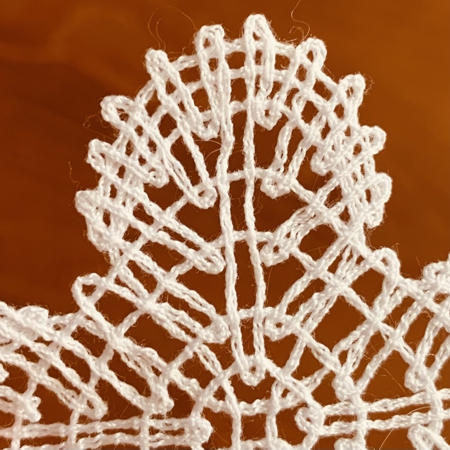These are instructions on how to embroider the Freestanding Bobbin Lace Doilies
|

|
There are 4 files in the set - 3 doilies and one test file. The average number of stitches in doilies is about 13,500, the average size is about 120mm x 120 mm. One color in all designs. All designs are embroidered in the same way.
|
The test file has 2964 stitches and is 59 mm x 59mm.
Important: Before embroidering a doily, make a stitch-out of the test file and wash away the stabilizer. This helps you to select the threads, needles, stabilizers and settings of your machine correctly. It's very important to select the correct thread tension!
|

|
Thread Tension is very important. When you embroider on fabric, it's recommended that the needle thread appears on the back of the embroidery. Then the embroidery looks neat and nice.
With the lace, it's important that the bobbin and needle threads meet halfway, in the center of the stabilizer layer. If you leave the tension as per fabric embroidery, your stitch-out may end up looking fuzzy.
You need either to reduce the tension of the bobbin thread, or increase the tension of the needle thread to make a stitch-out neat. Consult your machine's manual and/or dealer on how to do this. The tension is very individual for each machine.
On the photos below you can see the front and back of our test stitch-outs- both sides look the same.
|

|

|
| Stabilizers: We recommend to use water-soluble mesh, such as Vilene. Vilene D0102 is a non-woven dissolvable stabilizer which is imported into the US, is sold in large rolls and is sometimes packaged under different brand names. Some of these brand names are Fabri-Solvy by Sulky, Avalon Plus by Madeira, Wash-Away, and Aqua Magic. Film-like water soluble stabilizers, such as Solvy by Sulky, Avalon by Madeira and Badge Master are not suitable for Free-Standing Lace embroidery.
|

|
| Threads: The thinner the thread, the finer the final product will be. That is why for this project we recommend machine quilting cotton thread, which gives bulk to the lace and makes it look hand-made. Embroidery polyester thread will make very fine web-like lace.
Embroidery rayon thread is too soft, it does not keep its shape and often its color will fade under the influence of chemicals from the water-soluble mesh.
You can use 40-, 50- or even 60-weight cotton, and you can use it both in the bobbin and in the needle. If you use 50- or 60-weight cotton thread for the needle, you shoul use a thicker, 40-weight, cotton in the bobbin.
We used Signature machine quilting cotton thread both in the needle and in the bobbin, but similar threads from other companies should work just as well.
The drawback of cotton thread is lint. Please don't forget to clean the machine with a soft brush or compressed air after each embroidery.
To get two-sided embroidery, use threads of the same color in the needle and in the bobbin.
|

|
| Needles: We use size 80/12 embroidery needles and 80/12 metallic needles. Our experience shows that cotton thread used with metallic needles gives less lint. The needles should be sharp, so it's advisable to change them often. |

|
|
Washing out the Stabilizer:
|
| Rinsing away the stabilizer is also an important step, because the lace can be stretched or distorted if this is done incorrectly. We recommend to use a foam board and stainless pins. Cut away the excess stabilizer close to the stitches. Take your time and carefully pin every single loop on the lace's outer edge to the board.
Now place the board into a bowl with luke-warm water. Leave the board in the water for at least half an hour. Change the water a couple of times.
Take the board out of the water and leave to air dry. Do not unpin the lace until it's completely dry.
|
|
This stitch-out is used for demonstation purposes only.
|
|
| Have fun! |
|
Back to Freestanding Bobbin Lace Doilies
|
|
|
